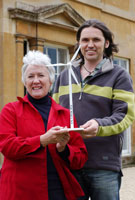|
 Green
building in Brooklyn Green
building in Brooklyn
Susan Boyle and her husband Benton Brown turned an abandoned warehouse
into a model of sustainable construction. With its planted roof, solar
panels, and lots of recycled materials, this project is easy on the
environment -- and the eyes. Find out how they did it:
Lofty
Ambitions by Amanda Griscom, 25 June 2004, Grist
Magazine
Susan Boyle: "We want people to see, intuit, and understand the difference
of a building like this," she said. "The higher goal here is simply
to motivate more people to want to live in this kind of environment
and take on similar steps or projects," she said. "We're basically in
the middle of an industrial sector. There's not a whole lot in the way
of parks or trees. So when people ride by on the elevated train and
see one rooftop covered with vegetation and another covered with solar,
it creates questions in their minds."
 some
resources and sources on information on women and environment some
resources and sources on information on women and environment
WEDO
Primer: Women and Sustainable Development


Local Agenda, May
2001
Section
III Mobilizing Women's Involvement
"Two
strategies for overcoming the barriers to women's participation in local
governance, based on WEDO's consultations with women leaders, NGOs and
community representatives..." See full report at:
http://www.wedo.org/sus_dev/section3.htm
 Selected
Sources-Women, Environment and Development
Selected
Sources-Women, Environment and Development
compiled
by Marlene Roy, International Institute for Sustainable Development,
Winnipeg, Manitoba.
 The
Women's Institute powers up with green Ecotricity (UK)
The
Women's Institute powers up with green Ecotricity (UK)
 |
15th
April 2003 - "The National Federation of Women's Institutes
(NFWI) is making a stand against the increasing threat of climate
change by joining up with Ecotricity, the world's first green electricity
company. With the environment high on the NFWI's agenda and climate
change and sustainable development a real concern amongst its 230,000
members, this powerful partnership aims to help clean up the UK's
electricity production..."
http://www.ecotricity.co.uk/code/popup_pr_WIapr03.html |
 The
internet "Grist
Magazine: gloom and doom with a sense of humor" features an
environmental column by Umbra Fisk. Besides the general questions she
answers, there is an archive on recycling. Here's a Q&A from that:
The
internet "Grist
Magazine: gloom and doom with a sense of humor" features an
environmental column by Umbra Fisk. Besides the general questions she
answers, there is an archive on recycling. Here's a Q&A from that:

The question, from
a reader wondering about the information on his box of crackers: What
is "pre-consumer" content? I mean, if the label is true ("carton made
from 100 percent recycled paperboard -- minimum 35 percent post-consumer
content"), what is the other 65 percent? And what is paperboard?
Umbra's answer:
"Pre-consumer content is the stuff picked up from the cutting-room
floor and recycled into new paper products. Paper that was wrinkled,
or the odds and ends of a sheet after the pattern was cut out for the
cereal box, or the fuzzy sides of a poured sheet, the "deckle" -- anything
left over after the first go-round. The 35 percent post-consumer content
is just what it says -- 35 percent of the material that went into your
paperboard had already been through consumer hands, while the other
65 percent consists of factory leftovers being given a new shot to make
it out into the consumer world. The box-maker may rely on government
contracts that mandate a specific percentage of recycled content. Paperboard
is paper more than 0.3 millimeters thick." see this and more at:
http://www.gristmagazine.com/ask/ask032504.asp
to
ecology menu
|



